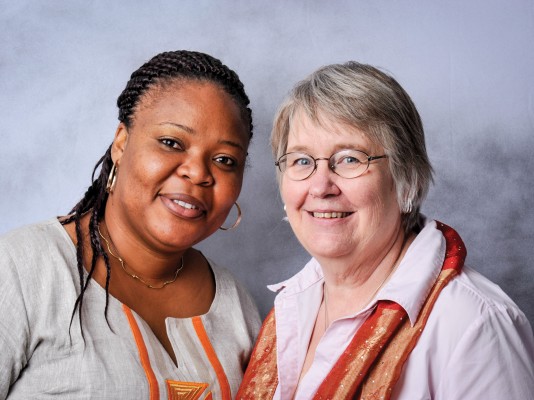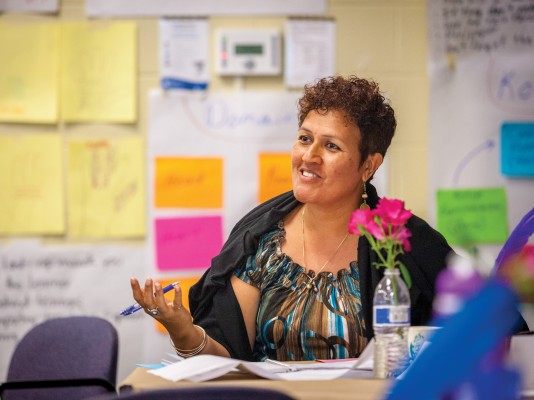
Supported by a grant from the United States Institute of Peace, a couple dozen people gathered at EMU for four days in the summer of 2004 to ponder lessons emerging from the first set of peacebuilding initiatives inspired by EMU’s Summer Peacebuilding Institute (SPI).
Of the nine initiatives, represented by people from 11 countries, five (in addition to SPI) have endured and offer intensive peacebuilding training to this day. Using the names by which they go today, these are the Nairobi Peace Initiative (headquartered in Kenya); West Africa Peacebuilding Institute (Ghana); Africa Peacebuilding Institute (South Africa); the Pacific Centre for Peacebuilding (Fiji); and the Mindanao Peacebuilding Institute (Philippines).
No institute was able to be immediately self-supporting. SPI, for example, received grant money from the Pew Trust when it was starting, enabling it to hire a separate administration and to have three years in which to build SPI’s reputation and allow it to become self-sufficient.
SPI also benefited from a relationship with organizations that identified people who should come for training and funded them. Mennonite Central Committee (MCC) sent 20 to 30 people to SPI in its early years, and Catholic Relief Services sent 10 or more.
The West Africa Network for Peacebuilding received $90,000 in seed money from the Winston Foundation when it started in 1998, which enabled it to gain sufficient credibility to launch its annual West Africa Peacebuilding Institute in 2002, supported for its first two years by a Hewlett grant.
Four of the five continuing initiatives (except for the Pacific Centre) received financial support from MCC in their early years, often in the form of providing funding for people to be trained at these centers, and sometimes with administrators and staffers paid by MCC.
14 Take-Aways
Fourteen lessons emerged from this gathering of 26 peacebuilders on May 30-June 4, 2004:*These nine lessons have been implemented to some extent in the 10 years since 2004:
- Institutes need start-up funding for a minimum of three years (and it’s likely to take about 10 years of trying various things to achieve income stability).
- Partnerships with organizations that can identify and fund participants to the trainings – as MCC or Catholic Relief Services did for SPI initially – are very important, especially when the institute is getting established.
- Institutes typically emerge as a result of the high energy and vision of a gifted, charismatic person or, in some cases, two people (though co-leadership has not proved enduring). If the institute is to thrive over the long term, however, focus and power must shift from the founding visionary to one of “collective decision-making power” based on transparency.
- Site visits, curriculum sharing and teaching stints by CJP faculty and other outside experts help tremendously in launching peacebuilding initiatives. CJP professor Lisa Schirch, for example, traveled to Fiji in 2001 to help with its first national peace workshop, and both Schirch and Howard Zehr, restorative justice expert at CJP, taught there in 2005 at sessions that fueled interest in launching the Pacific Centre for Peacebuilding two years later.
- Women can be a tremendous force in peacebuilding in that they often function well across ethnic and religious lines, but they need to be empowered, through targeted education, mentoring and support networks, to play that role.
- Co-teaching and instructors attending each other’s classes is recommended for cross-fertilization. A common instructor manual helps ensure a standard level of instruction, as was used and continues to be used at the Mindanao Peacebuilding Institute.
- Context-specific materials are best, drawing on indigenous traditions, languages, resources and knowledge, rather than simply transplanting materials developed in North America.
- Solidarity and cooperation among peacebuilders – whether from the northern hemisphere or southern – is to be valued. The North remains the home base of the majority of the funders of peacebuilding and has more pedagogical resources. The South is at the growing edge of the practice of peacebuilding.
- Interacting hospitably and developing relationships are integral to the training of peacebuilders. Institutes should not grow so fast or so large that these qualities are lost.
These next five 2004 lessons continued over the following decade to be ones largely not realized:
- Fledgling institutes with newly hired staff need to focus their attention on one or two strategic priorities in the peacebuilding arena, rather than risk over-extending themselves. (Bridge Builders would be an example of this model in that it has chosen to focus exclusively on conflicts within churches in the United Kingdom.)
- Positive relations with national governmental bodies should be sought, both for mutual understanding and to lessen organizational difficulties, such as obtaining visas to do peace work and attend trainings. (Four that do significant outreach to governmental bodies, including the police and military, are the West Africa Network for Peacebuilding –WANEP, headquartered in Ghana; JustaPaz in Mozambique; the Mindanao Peacebuilding Institute in the Philippines; and the Pacific Centre for Peacebuilding, headquartered in Fiji.)
- Links between peacebuilding institutes – and between them and other civil society organizations – need to be strengthened to exchange lessons, maximize their collective impact, and coordinate work. (The Northeast Asia Regional Peacebuilding Institute, headquartered in South Korea, and the Mindanao Peacebuilding Institute have found a way to connect at least annually – each summer a representative of each institute is given a free pass to attend the other’s summer session, not scheduled during the same weeks.)
- Practitioners around the globe need to document their experiences, expanding the field’s practice-knowledge and theoretical base, preferably through a regularly published journal. (Practicalities are the problem – practitioners tend to be doers, not academic-style writers in one of the globally dominant languages. And they wonder how they will support themselves if they did choose to step away and shape their experiences into publishable writings.)
- In-depth socio-economic analyses – incorporating such matters as poverty, lack of education, the impact of climate change – ought to be incorporated into the intervention strategies taught at peacebuilding institutes. (Efforts have been made, but there’s still much room for clarity on this matter, especially regarding viable systemic alternatives.)
Women Peacebuilders on the Upswing

Of the foregoing 14 lessons, the one on developing more women peacebuilders has taken flight most dramatically over the last decade. A brief overview:
In the early 2000s, WANEP provided support to Liberian social worker Leymah Gbowee, who organized the Women of Liberia Mass Action for Peace. This grassroots women’s organization was instrumental in ending Liberia’s war in 2003 and facilitating the 2005 election of Ellen Johnson Sirleaf, the first female president of an African nation.
Gbowee was also instrumental in forming two women’s organizations: Women in Peacebuilding Network under WANEP in 2001, followed by the Women Peace and Security Network Africa in 2006. In addition, her Gbowee Peace Foundation Africa gives special attention to educational and leadership opportunities for females in Liberia.
In June 2011, a by-invitation meeting at EMU of 18 women from eight nations (including Gbowee, who had earned an MA from CJP in 2007) concluded that there was a need for a program specifically tailored to women and women’s issues in peacebuilding. CJP’s Women’s Peacebuilding Leadership Program began under the leadership of Jan Jenner, MA ’99 , the following summer with 16 women from East and West Africa and nations in the South Pacific.

Today there are 45 alumni or enrollees in this Women’s Peacebuilding Leadership Program, which has been conducted partly at EMU and partly in the women’s home regions. Upon completion, they receive a graduate certificate in conflict transformation.
In 2004, representatives of the African Peacebuilding Institute (API) reported “a very low registration by women practitioners.” Ten years later, the situation was markedly different. “For the first time since the start of API in 2001, the number of female instructors sponsored by API exceeded the number of male,” said API’s 2014 report. And the number of female participants at API was at its highest yet: 16 out of 48 (30%).
In Fiji, a female graduate of CJP, Koila Costello-Olsson, is the executive director of the Pacific Centre for Peacebuilding, which has arranged for 19 to enter CJP’s Women’s Peacebuilding Leadership Program since 2012.
In the Philippines, the Mindanao Peacebuilding Institute is headed by Christina Vertucci, a former Mennonite Central Committee worker who attended SPI in 1996 and 1998.
A Few Unrealized Hopes
One concern expressed in 2004 – one that bedevils most institutes to this day – is that their funding was not long-term or sustainable. Most depended on outside support in 2004, typically time-limited grants, for more than half of their budget. And the donor pool was small – just five major funders were identified for four of the institutes in 2004. (This may explain why four of the nine institutes/initiatives represented at the 2004 conference do not exist today.)
“There is an urgent need to educate more funders on the need and the impact of the institutes,” said the 2004 Tending the Seed report. Donors need to be “constantly involved” in order to understand the fluidity of conflict situations and the importance of grassroots feedback. To be avoided, if at all possible: “transient donor paradigms” dictating what is done and in what time frame it is done, irrespective of the realities on the ground; plus, onerous reporting mechanisms.
Among hopes that have not been realized since 2004, the participants called for a gathering of peace institute representatives every two years to build a worldwide network of like-minded people and to discuss “what has worked and what has not worked.” (The 2004 gathering has not been repeated.)
They also called for a “common journal for peacebuilding institutes to encourage peace practitioners to contribute their experiences, for collaboration between regions, and for sharing of resources and skills that have worked in one region and may be applicable in other regions.” This, too, has not emerged.
* These were culled from Tending the Seed: Development and Growth of Regional Peace Institutes, a 2005 report provided to the conference funder, the United States Institute of Peace, and from a June 2004 article “Betwixt, Between and Beyond: Discerning the Invisible Web of Peacebuilding” by Babu Ayindo and Koila Costello-Olsson, edited by William Goldberg. Quotes are from these documents. Both reside in CJP’s archives.